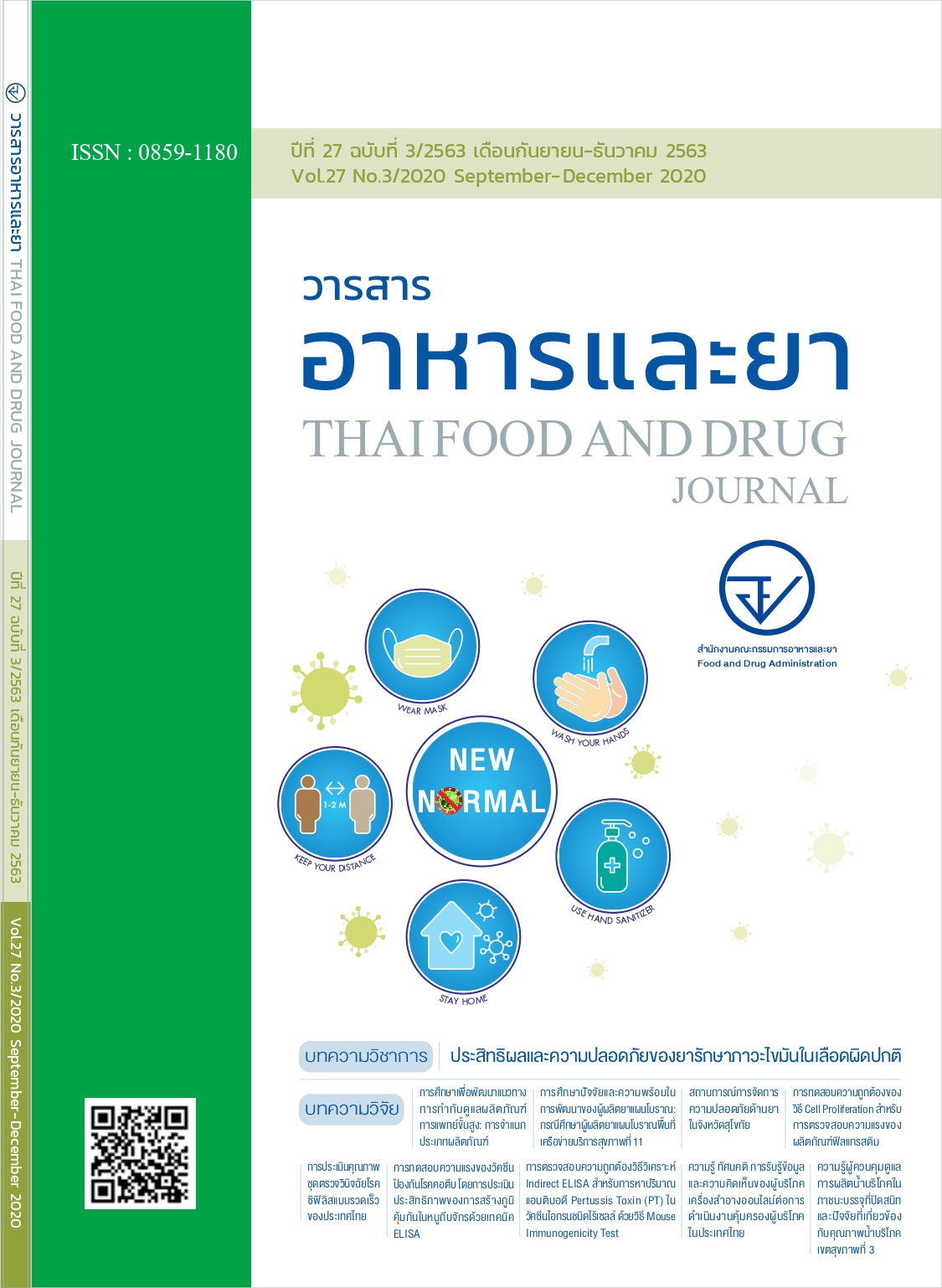ความรู้ผู้ควบคุมดูแลการผลิตน้ำบริโภคในภาชนะบรรจุที่ปิดสนิม และปัจจัยที่เกี่ยวข้องกับคุณภาพน้ำบริโภค เขตสุขภาพที่ 3
Main Article Content
บทคัดย่อ
การศึกษานี้มีวัตถุประสงค์เพื่อศึกษาความรู้เกี่ยวกับข้อกฎหมายข้อบังคับที่เกี่ยวกับการผลิตนํ้าบริโภค
ในภาชนะบรรจุที่ปิดสนิทและการควบคุมดูแลการผลิตของผู้ควบคุมดูแลการผลิต และศึกษาปัจจัยที่เกี่ยวข้องกับ
คุณภาพมาตรฐานนํ้าบริโภคในภาชนะบรรจุที่ปิดสนิท โดยใช้แบบสอบถาม สอบถามผู้ควบคุมดูแลการผลิตของ
สถานที่รับใบอนุญาตผลิตนํ้าบริโภคในภาชนะบรรจุที่ปิดสนิทในเขตสุขภาพที่ 3 ทั้งหมดจำนวน 363 แห่ง ได้รับ
การตอบกลับจำนวน 156 แบบ และมีการเก็บตัวอย่างและมีรายงานผลวิเคราะห์คุณภาพตัวอย่างผลิตภัณฑ์นํ้าดื่ม
จากสถานที่ผลิตดังกล่าวจำนวน 112 แห่ง เพื่อนำมาศึกษาความสัมพันธ์ระหว่างความรู้กับคุณภาพนํ้าบริโภค
ผลการศึกษาคะแนนความรู้ พบว่า ผู้ควบคุมดูแลการผลิตมีคะแนนความรู้ด้านกฎหมายเฉลี่ย 13.71 ซึ่งน้อยกว่า
คะแนนด้านการควบคุมดูแลการผลิตที่มีค่าเฉลี่ย 19.98 อย่างมีนัยสำคัญทางสถิติที่ P<0.01 โดยที่คะแนนความรู้
เฉลี่ยแต่ละจังหวัดไม่มีความแตกต่างกัน และเมื่อศึกษาคะแนนความรู้ทั้งด้านกฎหมาย การควบคุมดูแลการผลิต
และคะแนนรวมทั้งสองด้าน รวมถึงปัจจัยที่เกี่ยวข้องได้แก่ เพศ ระดับการศึกษา ระดับรายได้ผู้ควบคุมดูแลการผลิต
เขตชุมชนที่ตั้ง แหล่งนํ้าดิบ และระบบการผลิต มาวิเคราะห์ความสัมพันธ์ร่วมกับผลการตรวจวิเคราะห์มาตรฐาน
ผลิตภัณฑ์นํ้าบริโภคของสถานประกอบการ 112 แห่ง โดยในส่วนของความรู้ แยกกลุ่มสถานประกอบการเป็นกลุ่ม
ที่มีคะแนนมาก และมีคะแนนน้อยกว่าค่าเฉลี่ยเขต ตามประเภทคะแนนทั้งสามกลุ่มคะแนน ผลการวิเคราะห์พบว่า
ความรู้คะแนนความรู้รวม และระดับรายได้มีความสัมพันธ์กันคุณภาพนํ้าบริโภค อย่างมีนัยสำคัญที่ P=0.017 และ
0.019 ตามลำดับ
Article Details
เอกสารอ้างอิง
พ.ศ. 2560 [อินเทอร์เน็ต]. 2560 [เข้าถึงเมื่อ 20 กุมภาพันธ์ 2563] .เข้าถึงได้จาก : http://www.fda.moph.go.th/sites/kbs/Shared%20Documents/เกี่ยวกับส่วนภูมิภาค/KBS_Report_2560_Web.pdf
2. กองส่งเสริมงานคุ้มครองคุ้มครองผู้บริโภคด้านผลิตภัณฑ์สุขภาพ สำนักงานคณะกรรมการอาหารและยา. สรุปผลการดำเนินงานคุ้มครองผู้บริโภคด้านผลิตภัณฑ์สุขภาพในส่วนภูมิภาค ปีงบประมาณ
พ.ศ. 2559. [อินเทอร์เน็ต]. 2559 [เข้าถึงเมื่อ 20 กุมภาพันธ์ 2563]. เข้าถึงได้จาก : http://www.fda.moph.go.th/sites/kbs/Shared%20Documents/Report_KBS/Report4.pdf
3. จิราภร เพชรรักษ์, สุภาทินี โสบุญ, สุนันทา อุไรโรจน์.คุณภาพนํ้าบริโภคในภาชนะบรรจุที่ปิดสนิทและนํ้าแข็งในประเทศไทย ปีงบประมาณ พ.ศ. 2558.[อินเทอร์เน็ต]. 2558 [เข้าถึงเมื่อ 20 ธันวาคม 2562].
เข้าถึงได้จาก: http://e-library.dmsc.moph.go.th/ebooks/files/P3-6%20จิราภรณ์.pdf
4. สำนักนโยบายและแผนยุทธศาสตร์สำนักงานปลัดกระทรวงสาธารณสุข. แผนยุทธศาสตร์กระทรวงสาธารณสุข ปีงบประมาณ พ.ศ. 2560. [อินเทอร์เน็ต]2560. [เข้าถึงเมื่อ 20 ธันวาคม 2562]. เข้าถึงได้
จาก: http://wops.moph.go.th/ops/oic/data/20180315154733_1_.pdf
5. สุพัตรา คงจริง, สงวน ลือเกียรติบัณฑิต. การประเมินสถานที่ผลิตนํ้าบริโภคในภาชนะบรรจุที่ปิดสนิทโดยชุมชนในจังหวัดตรังตามหลักเกณฑ์วิธีการที่ดีในการผลิต และคุณภาพนํ้าที่ผลิตได้. วารสาร
เภสัชกรรมไทย 2555;2(4):65–70.
6. ณรงค์ ฉายากุล และคณะ. สภาวการณ์นํ้าบริโภคในภาชนะบรรจุที่ปิดสนิทในเขต 12 ปี พ.ศ. 2542.เอกสารวิชาการ [อินเทอร์เน็ต]. 2542 [เข้าถึงเมื่อ20 ธันวาคม 2562] ;1-41. เข้าถึงได้จาก : http://
elib.fda.moph.go.th/elib/cgi-bin/opacexe.exe?op=q,c1s,Main,6131
7. ฉวีวรรณ นวจินดา และคณะ. ปัจจัยการผลิตที่มีผลกระทบต่อคุณภาพนํ้าบริโภคในภาชนะบรรจุที่ปิดสนิท. วารสารอาหารและยา 2541;1-3(4):22-34.


